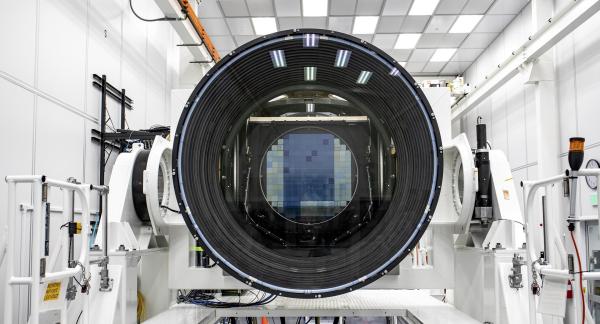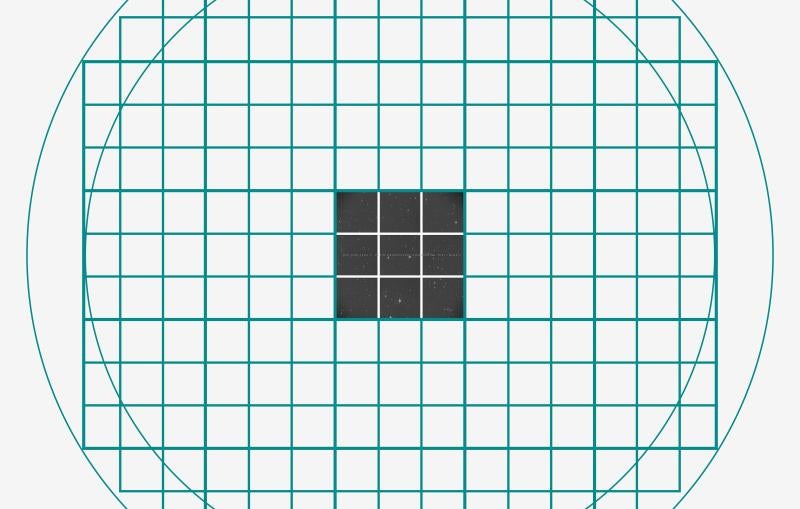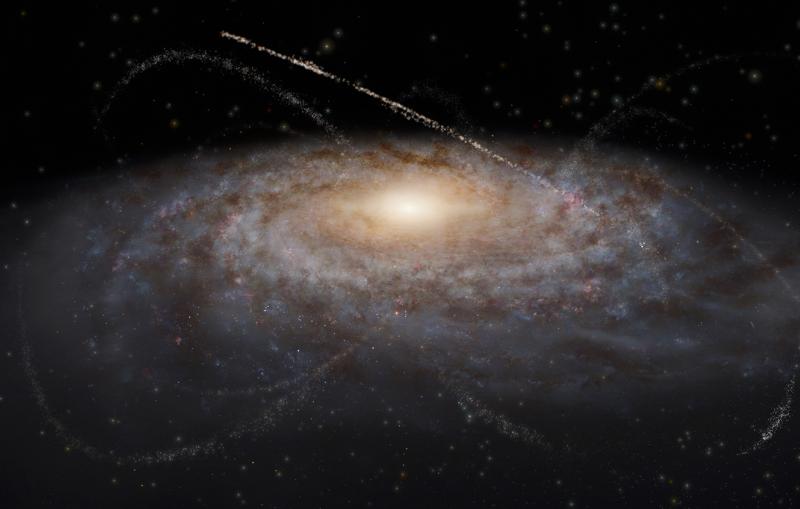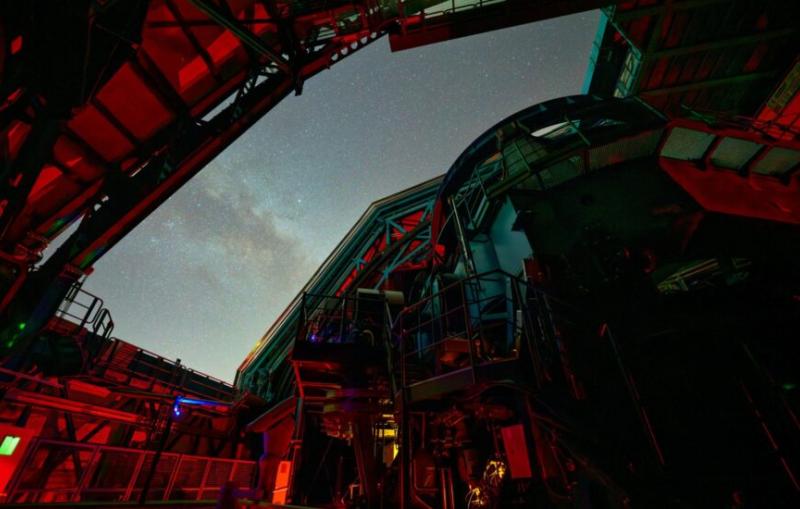Rubin Observatory will help unravel mysteries of dark matter and dark energy
Vera C. Rubin Observatory’s unprecedented deep and wide survey will create most precise map of Universe ever.
LSST Camera
Vera C. Rubin Observatory will search wide and deep into the cosmos for signs of dark matter and dark energy and yield new insights into our own galaxy and solar system. SLAC built Rubin's LSST Camera (above), the largest camera ever built for astrophysics. SLAC will also host Rubin's U.S. Data Facility and co-lead the observatory's operations along with NSF's NOIRLab. (Image Credit: Jacqueline Ramseyer Orrell/SLAC National Accelerator Laboratory)

Everything we know — galaxies, stars, planets, our families, friends, and even pets — makes up just 5% of the Universe. The remaining 95% is made up of mysterious components that scientists call dark energy (68%) and dark matter (27%). What are they, and how do they influence the structure and evolution of the Universe? Researchers like Andrés Alejandro Plazas Malagón, Rubin Operations Scientist at SLAC National Laboratory and Community Scientist and Calibration Scientist at Rubin Observatory, hope to tackle these questions with the upcoming Legacy Survey of Space and Time (LSST), conducted with Rubin Observatory in Chile. With its immense sky coverage and ability to detect faint objects, Rubin’s LSST will provide scientists with the enormous dataset needed to unravel these and other mysteries of the Universe.
In the 1970s American astronomer Vera C. Rubin provided the most convincing evidence at that time for the existence of an unseen ‘dark’ matter in the Universe. Dark matter is called dark because that’s pretty much all we know about it, other than its gravitational influence on stars and gas in galaxies: it’s a substance in the Universe that has mass but doesn’t give off or reflect light. This invisible material makes up about 80% of all matter, and its properties affect how the Universe evolves — how galaxies form and grow as well as how they clump together to form long filaments that make up the structure scientists call the cosmic web.
But shaping the large-scale structure of the Universe is a game of cosmic tug-of-war between dark matter and an elusive force known as dark energy. “You can think of dark matter as trying to build the cosmic structures, while dark energy is actually trying to dilute them and push them apart,” says Plazas Malagón. Most scientists think that dark energy drives the accelerating expansion of the Universe, and that its behavior is described by a quantity known as the cosmological constant. This explanation is commonly agreed on because it aligns with the evidence we’ve collected so far. But, while the cosmological constant is currently a fundamental piece of the equations that describe the Universe, researchers are still trying to pin down its exact value — and whether it’s the explanation for dark energy at all.
Calculating the cosmological constant, and thus placing firm constraints on the equations describing the Universe, is an effort at the forefront of cosmology. And Rubin will enable the most precise measurements of it yet by opening new possibilities for using a subtle effect called weak gravitational lensing to explore the complex interplay between dark matter and dark energy.
Cosmologists use weak lensing to infer the ‘clumpiness’ of matter by observing how its gravity bends light. But unlike strong gravitational lensing, which often produces giant, beautiful arcs around clusters of galaxies, weak lensing produces effects that are less dramatic: tiny distortions of the light from distant galaxies. While weak lensing can occur at the outskirts of a strong lensing system, it also exists everywhere across the Universe as light from background galaxies makes its way through the filaments of galaxies connecting galaxy clusters and superclusters known as the cosmic web. “If strong lensing is like looking through the bottom of a wine glass, weak lensing is like looking through a large, very subtly warped window,” says Theo Schutt, a PhD candidate at Stanford University who collaborates with Plazas Malagón.
These weak distortions of distant galaxies are too slight to be measured by observing just a single galaxy — even with data from thousands of galaxies, scientists can’t tell whether individual galaxies’ observed shapes are their true shapes or whether they’ve been distorted by weak lensing. To really understand the big picture, they need a big dataset to calculate the collective distortion across the entire observable sky. Rubin Observatory, with its ability to observe huge patches of the sky while also being able to see very faint and distant galaxies, will be the first observatory in history to provide data on not just millions, but billions of galaxies and their shapes.
Rubin Observatory will be a leading resource for cutting-edge astronomy and astrophysics when it comes online in 2025. Using an 8.4-meter telescope equipped with the largest digital camera in the world, it will scan the entire southern hemisphere sky every few nights for ten years, providing the most comprehensive view of the Universe we’ve ever seen. Rubin Observatory is jointly funded by the National Science Foundation (NSF) and the US Department of Energy (DOE). Rubin is a Program of NSF’s NOIRLab, which, along with SLAC National Accelerator Laboratory, will operate Rubin.
Current surveys, such as the Dark Energy Survey, the Hyper Suprime Cam survey, and the Kilo-Degree Survey, are already untangling some of the mysteries of dark matter and dark energy. But there is a trade-off, explains Plazas Malagón, between a wide survey and a deep survey, limited by factors such as camera size and resolving power. The LSST Camera at Rubin Observatory has the unmatched wide-field view and high resolution that give astronomers and astrophysicists the best of both worlds. In fact, Rubin Observatory was designed from the start to help scientists map dark matter in the Universe using gravitational lensing of billions of distant galaxies.
“With Rubin, we’re going to have everything,” said Plazas Malagón. “We’re going to measure the properties of vastly more galaxies than what we have now, which is going to give us the statistical power to use weak lensing to both map the distribution of dark matter and study how dark energy evolves with time.”
It’s also possible that Rubin will produce new evidence to support alternative explanations for the phenomena we observe in our Universe beyond the most common theories of dark matter and dark energy.
“Dark energy is a concept that fits with the accepted theory of gravity within Einstein’s general theory of relativity,” said Plazas Malagón, “but Rubin and the LSST will also allow us to explore alternatives to that, which is incredibly exciting as well.”
Rubin Observatory is a joint initiative of the National Science Foundation (NSF) and the Department of Energy (DOE). Rubin is operated jointly by NSF’s NOIRLab and SLAC.
This article is based on a story from the Rubin Observatory.
For questions or comments, contact the SLAC Office of Communications at communications@slac.stanford.edu.
About SLAC
SLAC National Accelerator Laboratory explores how the universe works at the biggest, smallest and fastest scales and invents powerful tools used by researchers around the globe. As world leaders in ultrafast science and bold explorers of the physics of the universe, we forge new ground in understanding our origins and building a healthier and more sustainable future. Our discovery and innovation help develop new materials and chemical processes and open unprecedented views of the cosmos and life’s most delicate machinery. Building on more than 60 years of visionary research, we help shape the future by advancing areas such as quantum technology, scientific computing and the development of next-generation accelerators.
SLAC is operated by Stanford University for the U.S. Department of Energy’s Office of Science. The Office of Science is the single largest supporter of basic research in the physical sciences in the United States and is working to address some of the most pressing challenges of our time.






